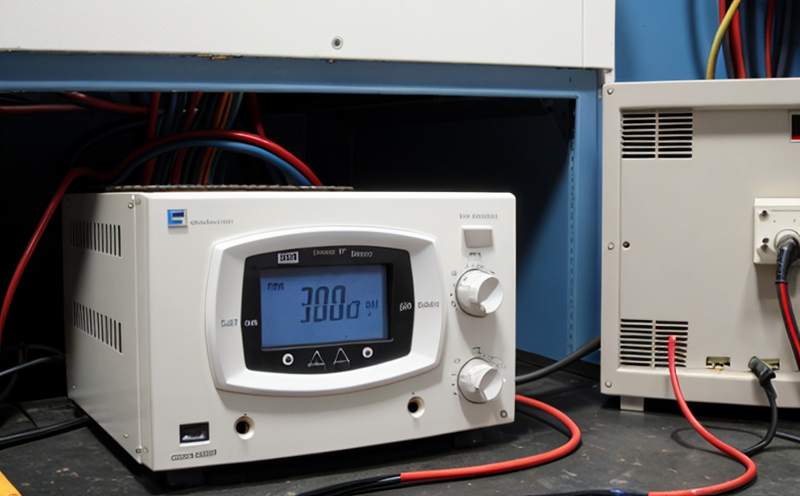IEC 61000 3 3 Voltage Fluctuation and Flicker Testing in Lighting Systems
The International Electrotechnical Commission (IEC) standard, IEC 61000-3-3, is designed to ensure that electrical equipment can function reliably within the voltage fluctuations and flicker that occur in real-world power systems. This standard plays a crucial role in maintaining the quality of lighting systems, particularly those used in sensitive environments such as offices, hospitals, and educational institutions.
Lighting systems are not just about providing light; they also contribute to the overall comfort and efficiency of an environment. Voltage fluctuations can lead to flicker, which is a visible fluctuation in the brightness of lights. Prolonged exposure to flicker can cause discomfort, reduce productivity, and even pose health risks such as eye strain or headaches. Therefore, ensuring that lighting systems comply with IEC 61000-3-3 standards helps mitigate these issues.
The standard specifies limits for both voltage fluctuations and flicker in terms of their perceived effects on human vision. These limits are designed to ensure that the light produced by lamps remains stable enough not only for visual comfort but also to avoid potential hazards. The testing procedures outlined in this standard help manufacturers and installers verify that their products meet these stringent requirements.
Compliance with IEC 61000-3-3 is essential for several reasons. First, it ensures that the lighting systems are reliable and safe to use. Second, it helps maintain a consistent light environment, which can significantly enhance productivity and well-being in workspaces. Lastly, compliance enhances the overall quality of life by reducing the occurrence of adverse health effects associated with flicker.
The testing process for IEC 61000-3-3 involves measuring both the voltage fluctuations and the flicker within a given lighting system. This measurement is conducted under specific conditions that simulate real-world power supply characteristics. The apparatus used typically includes specialized equipment capable of accurately detecting even minor variations in voltage and light intensity.
The acceptance criteria for this standard are based on perceived effects, meaning they consider how these fluctuations might be experienced by an average person. By adhering to these standards, lighting systems can achieve a high level of performance that is both reliable and safe. This compliance also facilitates smoother interactions between different components within the lighting system, ensuring optimal operation.
Testing for IEC 61000-3-3 requires careful preparation and execution. Specimen preparation involves setting up the lighting system in an environment that closely mimics real-world conditions. The apparatus used must be capable of capturing precise measurements over extended periods to ensure accurate data collection. Once the setup is complete, testing begins by applying various stress scenarios designed to simulate typical usage patterns.
The results of these tests are then analyzed using sophisticated software tools provided by the equipment manufacturer. These analyses focus on identifying any deviations from specified limits set forth in IEC 61000-3-3. Any discrepancies found during testing must be addressed and corrected before final certification can be issued.
Benefits
- Ensures safety and reliability of lighting systems.
- Maintains a stable light environment, enhancing productivity and comfort.
- Avoids potential health risks associated with flicker.
- Facilitates smoother interactions between different components within the lighting system.
Quality and Reliability Assurance
Compliance with IEC 61000-3-3 not only guarantees that a lighting system functions safely but also ensures its long-term reliability. By adhering to these standards, manufacturers can produce products that consistently meet or exceed expectations, thereby building trust among customers and stakeholders.
Quality assurance processes are integral to achieving compliance with IEC 61000-3-3. These processes involve rigorous testing at various stages of product development—from initial design through final assembly. Regular audits and reviews help identify any areas needing improvement or adjustment, ensuring continuous quality improvement throughout the lifecycle of a lighting system.
Reliability assurance focuses on maintaining consistent performance over time. This involves monitoring field performance after deployment to detect early signs of degradation or failure. Proactive maintenance strategies can then be implemented to address issues before they become critical, extending the useful life of the lighting system and minimizing downtime.
Customer Impact and Satisfaction
The impact of IEC 61000-3-3 compliance extends beyond mere technical specifications; it directly influences customer satisfaction. Customers benefit from a safer, more comfortable environment where flicker is minimized or eliminated entirely. This leads to increased productivity in workspaces and improved overall well-being.
For quality managers and compliance officers, ensuring adherence to this standard demonstrates a commitment to excellence. It showcases the organization’s dedication to delivering high-quality products that meet international standards, thereby enhancing brand reputation and customer loyalty.
Frequently Asked Questions
- Ensures safety and reliability of lighting systems.
- Maintains a stable light environment, enhancing productivity and comfort.
- Avoids potential health risks associated with flicker.
- Facilitates smoother interactions between different components within the lighting system.





